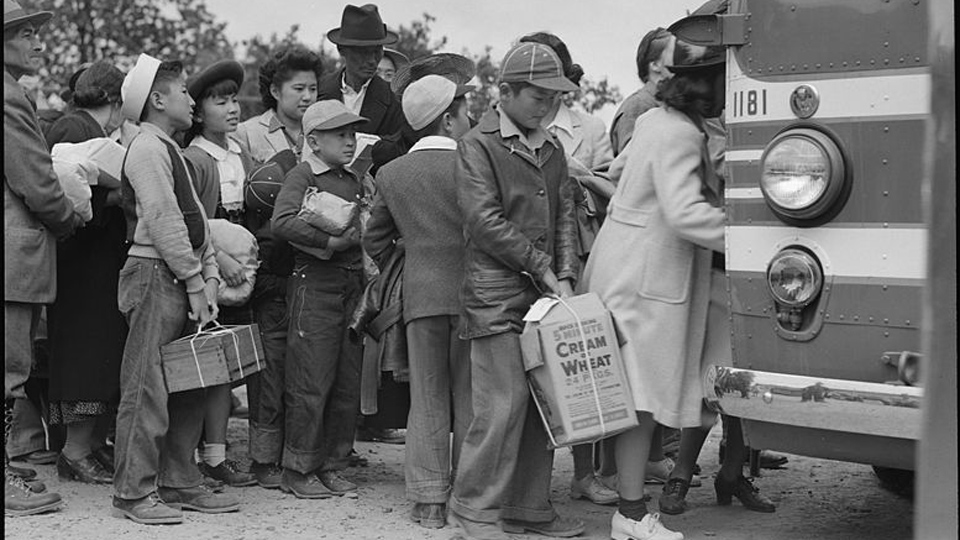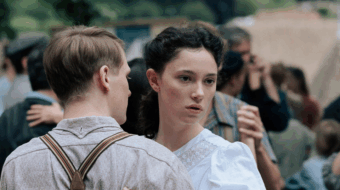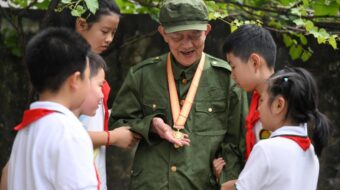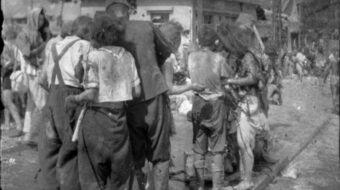
VAN NUYS, Calif. — A new oratorio, In America, written by Van Nuys High School students in the San Fernando Valley about the World War II-era Japanese American incarceration camps, received its premiere last week with a school performance on Thursday and a free public performance on Saturday. Some 85 student choral singers took part in the production, accompanied by a seven-piece instrumental ensemble.
It was a profoundly moving work on several levels, and a successful collaboration involving the public schools, private and public foundations, and the Los Angeles Master Chorale (LAMC).
The project was timed to coincide with the 75th anniversary of President Franklin D. Roosevelt’s signing of Executive Order 9066 on February 19, 1942, that resulted in the forced removal and incarceration of around 120,000 Japanese Americans for the duration of the war. The Japanese American community held Day of Remembrance events throughout the weekend.
The LAMC is widely recognized as one of the country’s leading professional choruses and one of Southern California’s most vibrant cultural treasures. Out of its commitment to community engagement and fostering music education in schools, LAMC sponsors an Oratorio Project for high school students that encourages young people to write and perform a major musical work.
Each year, a historical event or epic story is selected as the subject for the oratorio. This year’s topic of Japanese American incarceration was chosen in August and the students began the project in September.
To further enhance their understanding of the camps and the impact of Executive Order 9066, the students visited the Japanese American National Museum (JANM) in downtown Los Angeles. Many of the museum’s docents and their families were incarcerated, providing valuable first-hand accounts of that time. The museum’s ongoing exhibit Common Ground: The Heart of Community documents 130 years of Japanese American immigration and history and includes a barrack building from the Heart Mountain concentration camp.
Although the project appeared back in the fall like a historical reflection, following November’s election, with deportations and ethnic registries making headlines, the students found that the topic had suddenly acquired stark relevance. The 45-minute oratorio they composed poses the question: “Where can I be American, if not in America?”
Many of the performers, ranging from 9th through 12th grade, were immigrants themselves. “This particular story has an immediacy for us in America right now,” said Doug Cooney, a professional lyricist provided by LAMC who guided the students in writing the libretto over the twenty weeks of the project.
LAMC also assigned two other teaching artists – performer Alice Kirwan Murray and composer David O – to work with the Van Nuys students on performance technique and creating the score. After the oratorio was completed, students auditioned for featured solo roles and were coached to bring out the mood and character of their parts. Eight LAMC singers joined the students in performance, providing additional professional guidance. The conductor was Brianne Arevalo, choral director of the Van Nuys High School choirs.
In America opens with an overture that promises something of great portent, followed by nine movements that loosely chronicle the life-changing events of those years — the forced exodus from communities, homes and farms, the adjustment to a barren, unfamiliar terrain, the experience of the “picture brides” (women who came to America to marry a stranger), the resilience of the inmates, the resisters, and the motivations for immigration.
The entire text helpfully appeared on a screen which also featured historical photographs of people in the camps.
The words not only looked forward to today’s immigrants seeking a better life for themselves and their children, they also looked back to earlier American history. A young African American singer, Isaiah Yiga, sang about people “locked away and never allowed to leave…losing who we are…citizens like you but suddenly now we are not.” It was impossible not to think of the millions of Africans yanked from their homes and shipped off to slavery in America.
The libretto also brought out the sad differentiation between Issei — first-generation immigrants, who could not become citizens or own property — and their American-born children, the Nisei, who in a reversal of traditional respect, now had to tell their parents how to behave and what to do.
The movement “Shikata Ga Nai” sang of the proud resolution “We can handle it,” the strong will of the incarcerated to take any indignity, rise above it, and survive.
Perhaps the most exciting movement of the oratorio is “No No,” set to a mambo beat, dealing with some young men’s two refusals: to agree to serve in the U.S. military and to swear unqualified allegiance to the United States, forswearing any loyalty to the Japanese emperor. These courageous “No No Boys,” viewed with general disdain at the time, later became regarded as heroic resisters of oppression. Other Japanese Americans served in the war’s European theater and achieved high distinction for valor.
At the end the oratorio bends toward universalizing the immigrant experience as the choristers call out where they are from — Japan, China, India, Russia and many other places, becoming a cacophony of voices that is America today. It sounded like a modern version of the once popular Earl Robinson-John Latouche cantata Ballad for Americans.
Looking out over the multi-ethnic chorus of singers on that Van Nuys High School stage, one could appreciate what the role of public education has always been in the United States, at least ideally, to foster integration and Americanization, and also familiarity with other languages, cultures, traditions and abilities. A school for democracy, now severely threatened by privatization and charter school programs that divide our students into discrete religious, racial and social groups.
The Oratorio Project is more than creating a piece of music to sing: It’s an integrated learning experience embracing history, English language, arts, technology and music. Our schools, and our young people, need so much more of this.










